E148 - Tesla's Strategy, Innovation, and Enterprise: Critical Analysis
VerifiedAdded on 2024/05/20
|13
|3413
|269
Essay
AI Summary
This essay provides a comprehensive analysis of Tesla's strategy, innovation, and enterprise, exploring the key drivers behind its success in the electric vehicle market. It evaluates Tesla's innovative approaches in shaping its entrepreneurial vision, identifying market opportunities through strategic frameworks. The analysis critically examines the application of Blue Ocean strategy in Tesla's business model, highlighting its unique position compared to traditional automotive manufacturers. The essay further delves into Tesla's supply chain management, growth strategies, production capabilities, inventory management, and distribution channels, showcasing how these elements contribute to the company's overall success and competitive advantage. The document is available on Desklib, a platform offering a wide range of study resources, including past papers and solved assignments, to support students' academic needs.
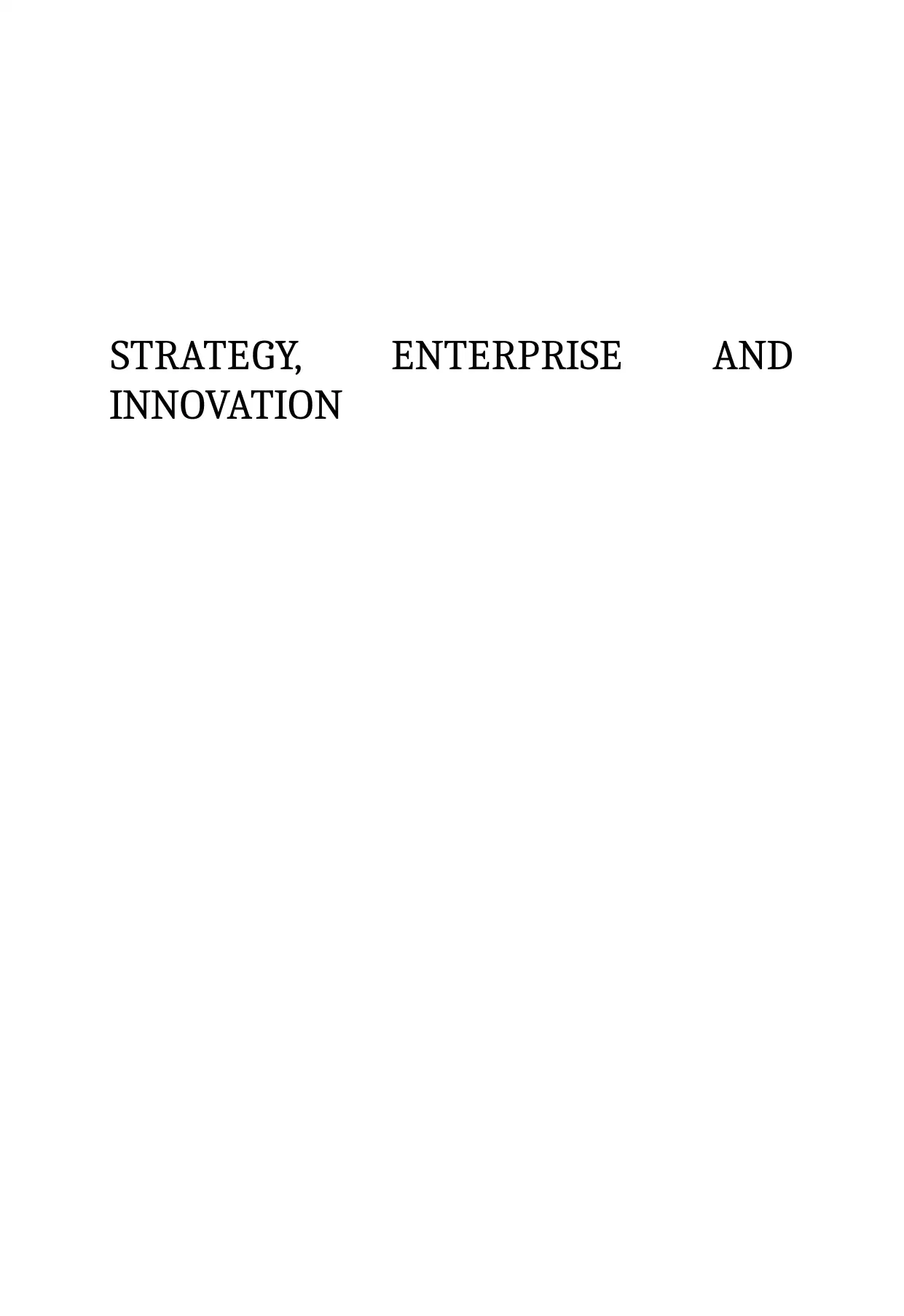
STRATEGY, ENTERPRISE AND
INNOVATION
INNOVATION
Paraphrase This Document
Need a fresh take? Get an instant paraphrase of this document with our AI Paraphraser
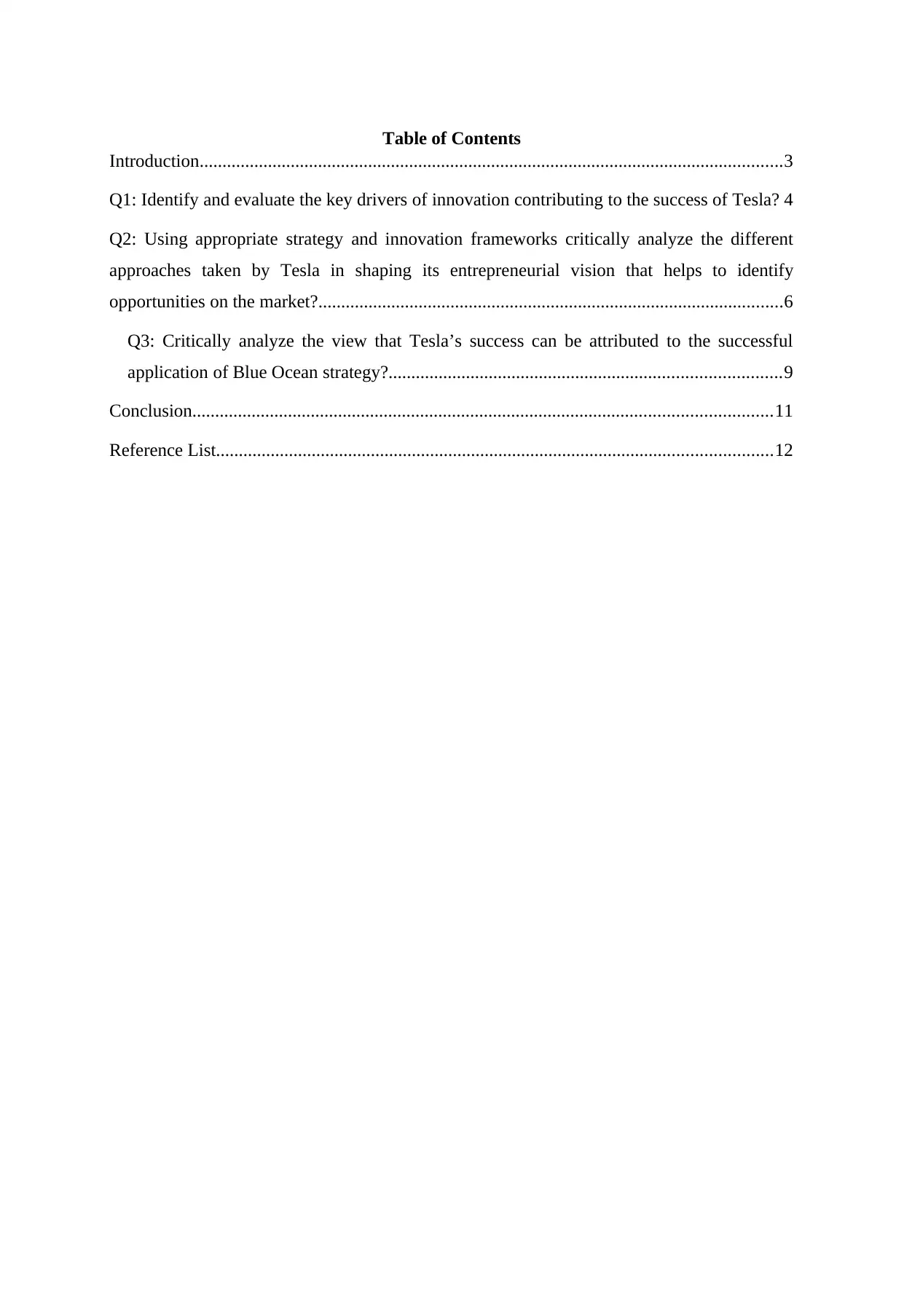
Table of Contents
Introduction................................................................................................................................3
Q1: Identify and evaluate the key drivers of innovation contributing to the success of Tesla? 4
Q2: Using appropriate strategy and innovation frameworks critically analyze the different
approaches taken by Tesla in shaping its entrepreneurial vision that helps to identify
opportunities on the market?......................................................................................................6
Q3: Critically analyze the view that Tesla’s success can be attributed to the successful
application of Blue Ocean strategy?......................................................................................9
Conclusion...............................................................................................................................11
Reference List..........................................................................................................................12
Introduction................................................................................................................................3
Q1: Identify and evaluate the key drivers of innovation contributing to the success of Tesla? 4
Q2: Using appropriate strategy and innovation frameworks critically analyze the different
approaches taken by Tesla in shaping its entrepreneurial vision that helps to identify
opportunities on the market?......................................................................................................6
Q3: Critically analyze the view that Tesla’s success can be attributed to the successful
application of Blue Ocean strategy?......................................................................................9
Conclusion...............................................................................................................................11
Reference List..........................................................................................................................12
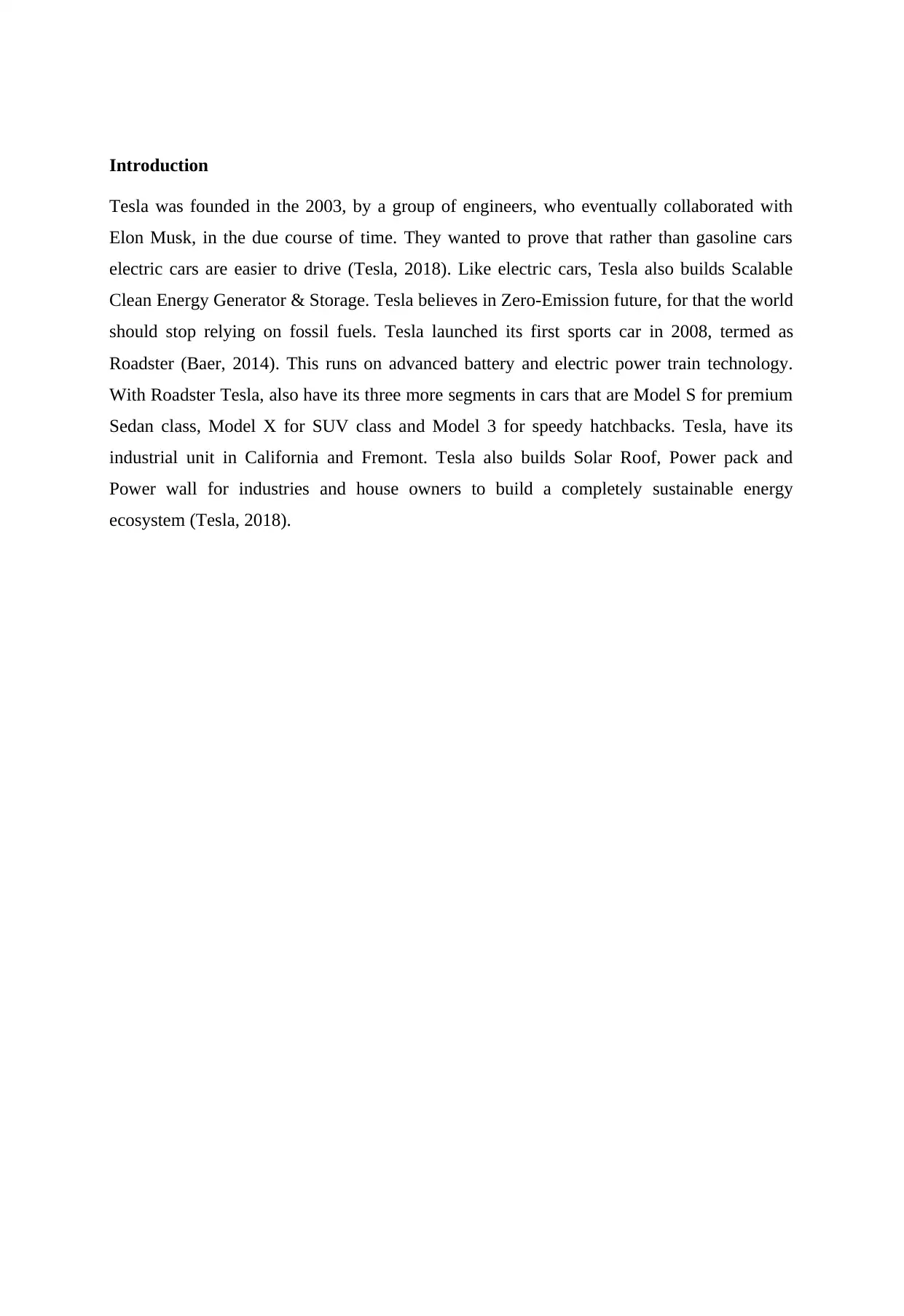
Introduction
Tesla was founded in the 2003, by a group of engineers, who eventually collaborated with
Elon Musk, in the due course of time. They wanted to prove that rather than gasoline cars
electric cars are easier to drive (Tesla, 2018). Like electric cars, Tesla also builds Scalable
Clean Energy Generator & Storage. Tesla believes in Zero-Emission future, for that the world
should stop relying on fossil fuels. Tesla launched its first sports car in 2008, termed as
Roadster (Baer, 2014). This runs on advanced battery and electric power train technology.
With Roadster Tesla, also have its three more segments in cars that are Model S for premium
Sedan class, Model X for SUV class and Model 3 for speedy hatchbacks. Tesla, have its
industrial unit in California and Fremont. Tesla also builds Solar Roof, Power pack and
Power wall for industries and house owners to build a completely sustainable energy
ecosystem (Tesla, 2018).
Tesla was founded in the 2003, by a group of engineers, who eventually collaborated with
Elon Musk, in the due course of time. They wanted to prove that rather than gasoline cars
electric cars are easier to drive (Tesla, 2018). Like electric cars, Tesla also builds Scalable
Clean Energy Generator & Storage. Tesla believes in Zero-Emission future, for that the world
should stop relying on fossil fuels. Tesla launched its first sports car in 2008, termed as
Roadster (Baer, 2014). This runs on advanced battery and electric power train technology.
With Roadster Tesla, also have its three more segments in cars that are Model S for premium
Sedan class, Model X for SUV class and Model 3 for speedy hatchbacks. Tesla, have its
industrial unit in California and Fremont. Tesla also builds Solar Roof, Power pack and
Power wall for industries and house owners to build a completely sustainable energy
ecosystem (Tesla, 2018).
⊘ This is a preview!⊘
Do you want full access?
Subscribe today to unlock all pages.

Trusted by 1+ million students worldwide
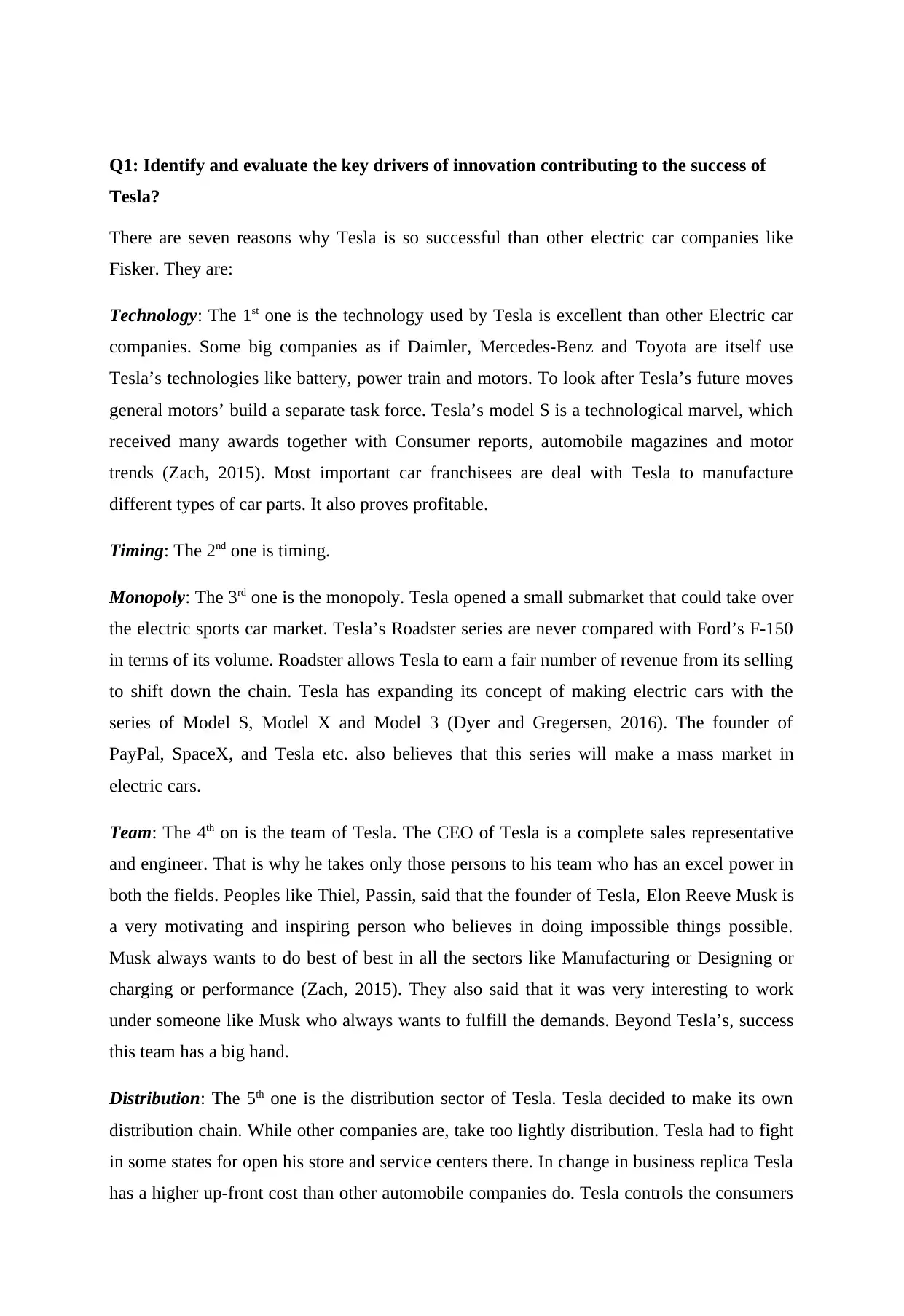
Q1: Identify and evaluate the key drivers of innovation contributing to the success of
Tesla?
There are seven reasons why Tesla is so successful than other electric car companies like
Fisker. They are:
Technology: The 1st one is the technology used by Tesla is excellent than other Electric car
companies. Some big companies as if Daimler, Mercedes-Benz and Toyota are itself use
Tesla’s technologies like battery, power train and motors. To look after Tesla’s future moves
general motors’ build a separate task force. Tesla’s model S is a technological marvel, which
received many awards together with Consumer reports, automobile magazines and motor
trends (Zach, 2015). Most important car franchisees are deal with Tesla to manufacture
different types of car parts. It also proves profitable.
Timing: The 2nd one is timing.
Monopoly: The 3rd one is the monopoly. Tesla opened a small submarket that could take over
the electric sports car market. Tesla’s Roadster series are never compared with Ford’s F-150
in terms of its volume. Roadster allows Tesla to earn a fair number of revenue from its selling
to shift down the chain. Tesla has expanding its concept of making electric cars with the
series of Model S, Model X and Model 3 (Dyer and Gregersen, 2016). The founder of
PayPal, SpaceX, and Tesla etc. also believes that this series will make a mass market in
electric cars.
Team: The 4th on is the team of Tesla. The CEO of Tesla is a complete sales representative
and engineer. That is why he takes only those persons to his team who has an excel power in
both the fields. Peoples like Thiel, Passin, said that the founder of Tesla, Elon Reeve Musk is
a very motivating and inspiring person who believes in doing impossible things possible.
Musk always wants to do best of best in all the sectors like Manufacturing or Designing or
charging or performance (Zach, 2015). They also said that it was very interesting to work
under someone like Musk who always wants to fulfill the demands. Beyond Tesla’s, success
this team has a big hand.
Distribution: The 5th one is the distribution sector of Tesla. Tesla decided to make its own
distribution chain. While other companies are, take too lightly distribution. Tesla had to fight
in some states for open his store and service centers there. In change in business replica Tesla
has a higher up-front cost than other automobile companies do. Tesla controls the consumers
Tesla?
There are seven reasons why Tesla is so successful than other electric car companies like
Fisker. They are:
Technology: The 1st one is the technology used by Tesla is excellent than other Electric car
companies. Some big companies as if Daimler, Mercedes-Benz and Toyota are itself use
Tesla’s technologies like battery, power train and motors. To look after Tesla’s future moves
general motors’ build a separate task force. Tesla’s model S is a technological marvel, which
received many awards together with Consumer reports, automobile magazines and motor
trends (Zach, 2015). Most important car franchisees are deal with Tesla to manufacture
different types of car parts. It also proves profitable.
Timing: The 2nd one is timing.
Monopoly: The 3rd one is the monopoly. Tesla opened a small submarket that could take over
the electric sports car market. Tesla’s Roadster series are never compared with Ford’s F-150
in terms of its volume. Roadster allows Tesla to earn a fair number of revenue from its selling
to shift down the chain. Tesla has expanding its concept of making electric cars with the
series of Model S, Model X and Model 3 (Dyer and Gregersen, 2016). The founder of
PayPal, SpaceX, and Tesla etc. also believes that this series will make a mass market in
electric cars.
Team: The 4th on is the team of Tesla. The CEO of Tesla is a complete sales representative
and engineer. That is why he takes only those persons to his team who has an excel power in
both the fields. Peoples like Thiel, Passin, said that the founder of Tesla, Elon Reeve Musk is
a very motivating and inspiring person who believes in doing impossible things possible.
Musk always wants to do best of best in all the sectors like Manufacturing or Designing or
charging or performance (Zach, 2015). They also said that it was very interesting to work
under someone like Musk who always wants to fulfill the demands. Beyond Tesla’s, success
this team has a big hand.
Distribution: The 5th one is the distribution sector of Tesla. Tesla decided to make its own
distribution chain. While other companies are, take too lightly distribution. Tesla had to fight
in some states for open his store and service centers there. In change in business replica Tesla
has a higher up-front cost than other automobile companies do. Tesla controls the consumers
Paraphrase This Document
Need a fresh take? Get an instant paraphrase of this document with our AI Paraphraser
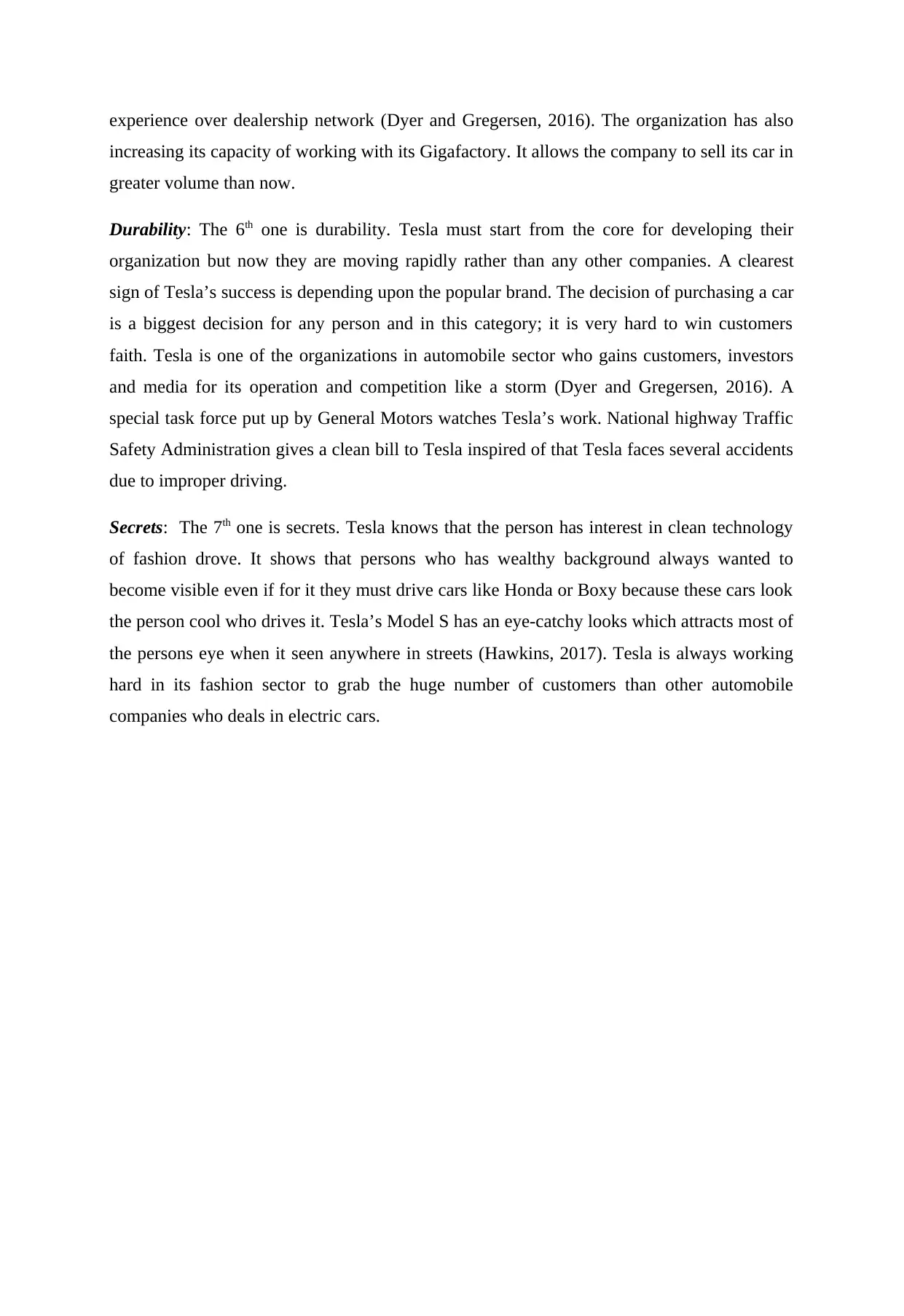
experience over dealership network (Dyer and Gregersen, 2016). The organization has also
increasing its capacity of working with its Gigafactory. It allows the company to sell its car in
greater volume than now.
Durability: The 6th one is durability. Tesla must start from the core for developing their
organization but now they are moving rapidly rather than any other companies. A clearest
sign of Tesla’s success is depending upon the popular brand. The decision of purchasing a car
is a biggest decision for any person and in this category; it is very hard to win customers
faith. Tesla is one of the organizations in automobile sector who gains customers, investors
and media for its operation and competition like a storm (Dyer and Gregersen, 2016). A
special task force put up by General Motors watches Tesla’s work. National highway Traffic
Safety Administration gives a clean bill to Tesla inspired of that Tesla faces several accidents
due to improper driving.
Secrets: The 7th one is secrets. Tesla knows that the person has interest in clean technology
of fashion drove. It shows that persons who has wealthy background always wanted to
become visible even if for it they must drive cars like Honda or Boxy because these cars look
the person cool who drives it. Tesla’s Model S has an eye-catchy looks which attracts most of
the persons eye when it seen anywhere in streets (Hawkins, 2017). Tesla is always working
hard in its fashion sector to grab the huge number of customers than other automobile
companies who deals in electric cars.
increasing its capacity of working with its Gigafactory. It allows the company to sell its car in
greater volume than now.
Durability: The 6th one is durability. Tesla must start from the core for developing their
organization but now they are moving rapidly rather than any other companies. A clearest
sign of Tesla’s success is depending upon the popular brand. The decision of purchasing a car
is a biggest decision for any person and in this category; it is very hard to win customers
faith. Tesla is one of the organizations in automobile sector who gains customers, investors
and media for its operation and competition like a storm (Dyer and Gregersen, 2016). A
special task force put up by General Motors watches Tesla’s work. National highway Traffic
Safety Administration gives a clean bill to Tesla inspired of that Tesla faces several accidents
due to improper driving.
Secrets: The 7th one is secrets. Tesla knows that the person has interest in clean technology
of fashion drove. It shows that persons who has wealthy background always wanted to
become visible even if for it they must drive cars like Honda or Boxy because these cars look
the person cool who drives it. Tesla’s Model S has an eye-catchy looks which attracts most of
the persons eye when it seen anywhere in streets (Hawkins, 2017). Tesla is always working
hard in its fashion sector to grab the huge number of customers than other automobile
companies who deals in electric cars.
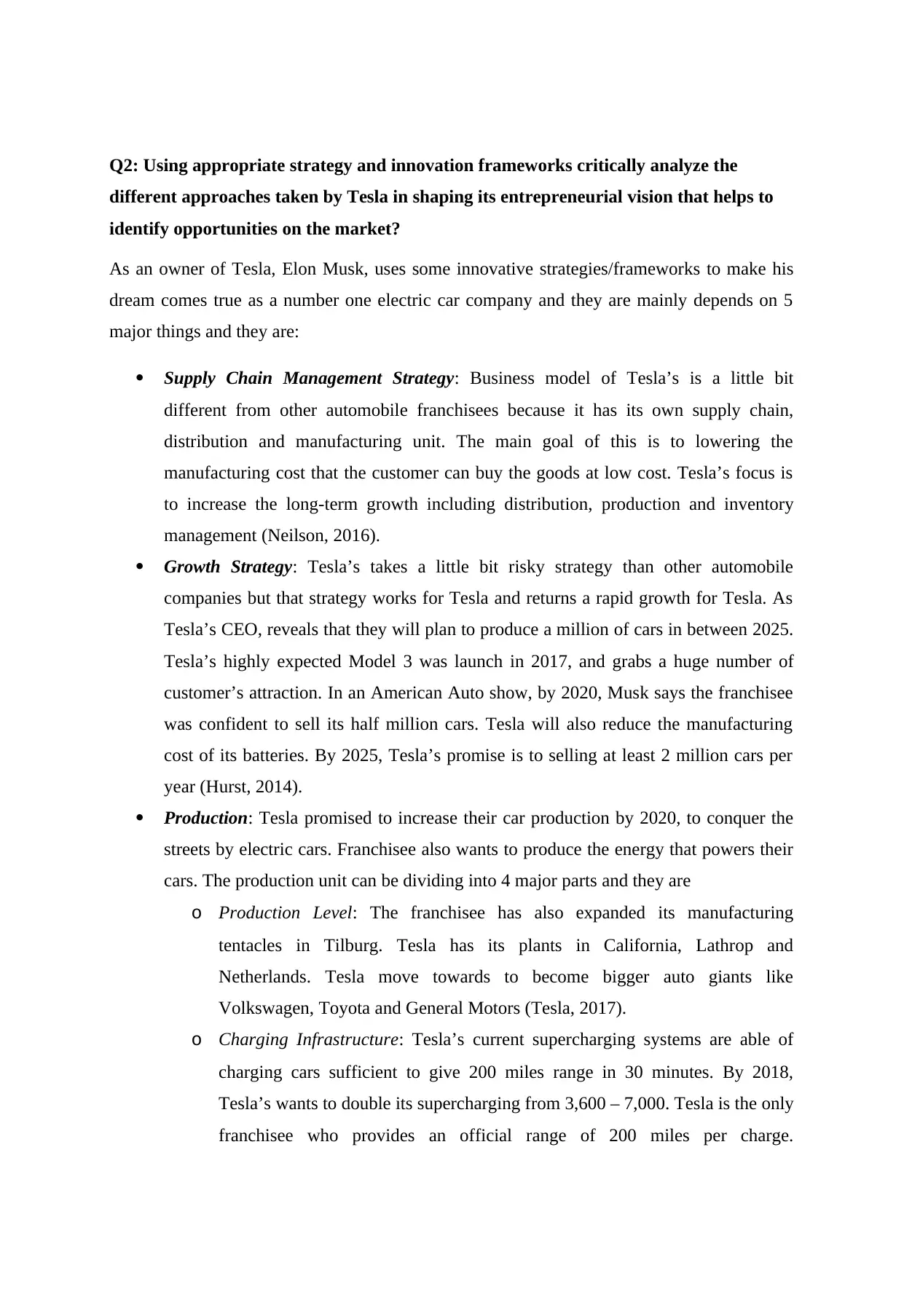
Q2: Using appropriate strategy and innovation frameworks critically analyze the
different approaches taken by Tesla in shaping its entrepreneurial vision that helps to
identify opportunities on the market?
As an owner of Tesla, Elon Musk, uses some innovative strategies/frameworks to make his
dream comes true as a number one electric car company and they are mainly depends on 5
major things and they are:
Supply Chain Management Strategy: Business model of Tesla’s is a little bit
different from other automobile franchisees because it has its own supply chain,
distribution and manufacturing unit. The main goal of this is to lowering the
manufacturing cost that the customer can buy the goods at low cost. Tesla’s focus is
to increase the long-term growth including distribution, production and inventory
management (Neilson, 2016).
Growth Strategy: Tesla’s takes a little bit risky strategy than other automobile
companies but that strategy works for Tesla and returns a rapid growth for Tesla. As
Tesla’s CEO, reveals that they will plan to produce a million of cars in between 2025.
Tesla’s highly expected Model 3 was launch in 2017, and grabs a huge number of
customer’s attraction. In an American Auto show, by 2020, Musk says the franchisee
was confident to sell its half million cars. Tesla will also reduce the manufacturing
cost of its batteries. By 2025, Tesla’s promise is to selling at least 2 million cars per
year (Hurst, 2014).
Production: Tesla promised to increase their car production by 2020, to conquer the
streets by electric cars. Franchisee also wants to produce the energy that powers their
cars. The production unit can be dividing into 4 major parts and they are
o Production Level: The franchisee has also expanded its manufacturing
tentacles in Tilburg. Tesla has its plants in California, Lathrop and
Netherlands. Tesla move towards to become bigger auto giants like
Volkswagen, Toyota and General Motors (Tesla, 2017).
o Charging Infrastructure: Tesla’s current supercharging systems are able of
charging cars sufficient to give 200 miles range in 30 minutes. By 2018,
Tesla’s wants to double its supercharging from 3,600 – 7,000. Tesla is the only
franchisee who provides an official range of 200 miles per charge.
different approaches taken by Tesla in shaping its entrepreneurial vision that helps to
identify opportunities on the market?
As an owner of Tesla, Elon Musk, uses some innovative strategies/frameworks to make his
dream comes true as a number one electric car company and they are mainly depends on 5
major things and they are:
Supply Chain Management Strategy: Business model of Tesla’s is a little bit
different from other automobile franchisees because it has its own supply chain,
distribution and manufacturing unit. The main goal of this is to lowering the
manufacturing cost that the customer can buy the goods at low cost. Tesla’s focus is
to increase the long-term growth including distribution, production and inventory
management (Neilson, 2016).
Growth Strategy: Tesla’s takes a little bit risky strategy than other automobile
companies but that strategy works for Tesla and returns a rapid growth for Tesla. As
Tesla’s CEO, reveals that they will plan to produce a million of cars in between 2025.
Tesla’s highly expected Model 3 was launch in 2017, and grabs a huge number of
customer’s attraction. In an American Auto show, by 2020, Musk says the franchisee
was confident to sell its half million cars. Tesla will also reduce the manufacturing
cost of its batteries. By 2025, Tesla’s promise is to selling at least 2 million cars per
year (Hurst, 2014).
Production: Tesla promised to increase their car production by 2020, to conquer the
streets by electric cars. Franchisee also wants to produce the energy that powers their
cars. The production unit can be dividing into 4 major parts and they are
o Production Level: The franchisee has also expanded its manufacturing
tentacles in Tilburg. Tesla has its plants in California, Lathrop and
Netherlands. Tesla move towards to become bigger auto giants like
Volkswagen, Toyota and General Motors (Tesla, 2017).
o Charging Infrastructure: Tesla’s current supercharging systems are able of
charging cars sufficient to give 200 miles range in 30 minutes. By 2018,
Tesla’s wants to double its supercharging from 3,600 – 7,000. Tesla is the only
franchisee who provides an official range of 200 miles per charge.
⊘ This is a preview!⊘
Do you want full access?
Subscribe today to unlock all pages.

Trusted by 1+ million students worldwide
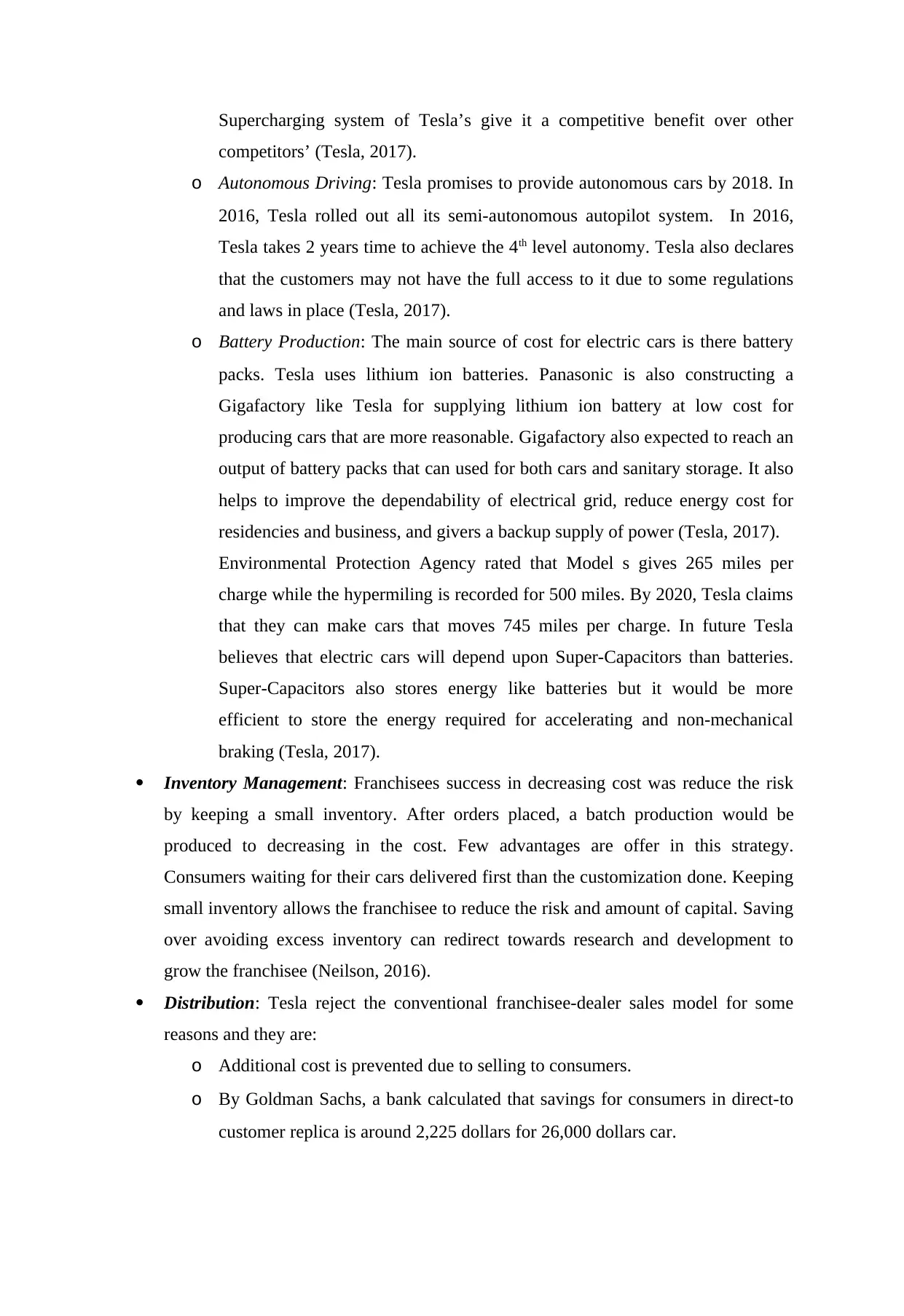
Supercharging system of Tesla’s give it a competitive benefit over other
competitors’ (Tesla, 2017).
o Autonomous Driving: Tesla promises to provide autonomous cars by 2018. In
2016, Tesla rolled out all its semi-autonomous autopilot system. In 2016,
Tesla takes 2 years time to achieve the 4th level autonomy. Tesla also declares
that the customers may not have the full access to it due to some regulations
and laws in place (Tesla, 2017).
o Battery Production: The main source of cost for electric cars is there battery
packs. Tesla uses lithium ion batteries. Panasonic is also constructing a
Gigafactory like Tesla for supplying lithium ion battery at low cost for
producing cars that are more reasonable. Gigafactory also expected to reach an
output of battery packs that can used for both cars and sanitary storage. It also
helps to improve the dependability of electrical grid, reduce energy cost for
residencies and business, and givers a backup supply of power (Tesla, 2017).
Environmental Protection Agency rated that Model s gives 265 miles per
charge while the hypermiling is recorded for 500 miles. By 2020, Tesla claims
that they can make cars that moves 745 miles per charge. In future Tesla
believes that electric cars will depend upon Super-Capacitors than batteries.
Super-Capacitors also stores energy like batteries but it would be more
efficient to store the energy required for accelerating and non-mechanical
braking (Tesla, 2017).
Inventory Management: Franchisees success in decreasing cost was reduce the risk
by keeping a small inventory. After orders placed, a batch production would be
produced to decreasing in the cost. Few advantages are offer in this strategy.
Consumers waiting for their cars delivered first than the customization done. Keeping
small inventory allows the franchisee to reduce the risk and amount of capital. Saving
over avoiding excess inventory can redirect towards research and development to
grow the franchisee (Neilson, 2016).
Distribution: Tesla reject the conventional franchisee-dealer sales model for some
reasons and they are:
o Additional cost is prevented due to selling to consumers.
o By Goldman Sachs, a bank calculated that savings for consumers in direct-to
customer replica is around 2,225 dollars for 26,000 dollars car.
competitors’ (Tesla, 2017).
o Autonomous Driving: Tesla promises to provide autonomous cars by 2018. In
2016, Tesla rolled out all its semi-autonomous autopilot system. In 2016,
Tesla takes 2 years time to achieve the 4th level autonomy. Tesla also declares
that the customers may not have the full access to it due to some regulations
and laws in place (Tesla, 2017).
o Battery Production: The main source of cost for electric cars is there battery
packs. Tesla uses lithium ion batteries. Panasonic is also constructing a
Gigafactory like Tesla for supplying lithium ion battery at low cost for
producing cars that are more reasonable. Gigafactory also expected to reach an
output of battery packs that can used for both cars and sanitary storage. It also
helps to improve the dependability of electrical grid, reduce energy cost for
residencies and business, and givers a backup supply of power (Tesla, 2017).
Environmental Protection Agency rated that Model s gives 265 miles per
charge while the hypermiling is recorded for 500 miles. By 2020, Tesla claims
that they can make cars that moves 745 miles per charge. In future Tesla
believes that electric cars will depend upon Super-Capacitors than batteries.
Super-Capacitors also stores energy like batteries but it would be more
efficient to store the energy required for accelerating and non-mechanical
braking (Tesla, 2017).
Inventory Management: Franchisees success in decreasing cost was reduce the risk
by keeping a small inventory. After orders placed, a batch production would be
produced to decreasing in the cost. Few advantages are offer in this strategy.
Consumers waiting for their cars delivered first than the customization done. Keeping
small inventory allows the franchisee to reduce the risk and amount of capital. Saving
over avoiding excess inventory can redirect towards research and development to
grow the franchisee (Neilson, 2016).
Distribution: Tesla reject the conventional franchisee-dealer sales model for some
reasons and they are:
o Additional cost is prevented due to selling to consumers.
o By Goldman Sachs, a bank calculated that savings for consumers in direct-to
customer replica is around 2,225 dollars for 26,000 dollars car.
Paraphrase This Document
Need a fresh take? Get an instant paraphrase of this document with our AI Paraphraser
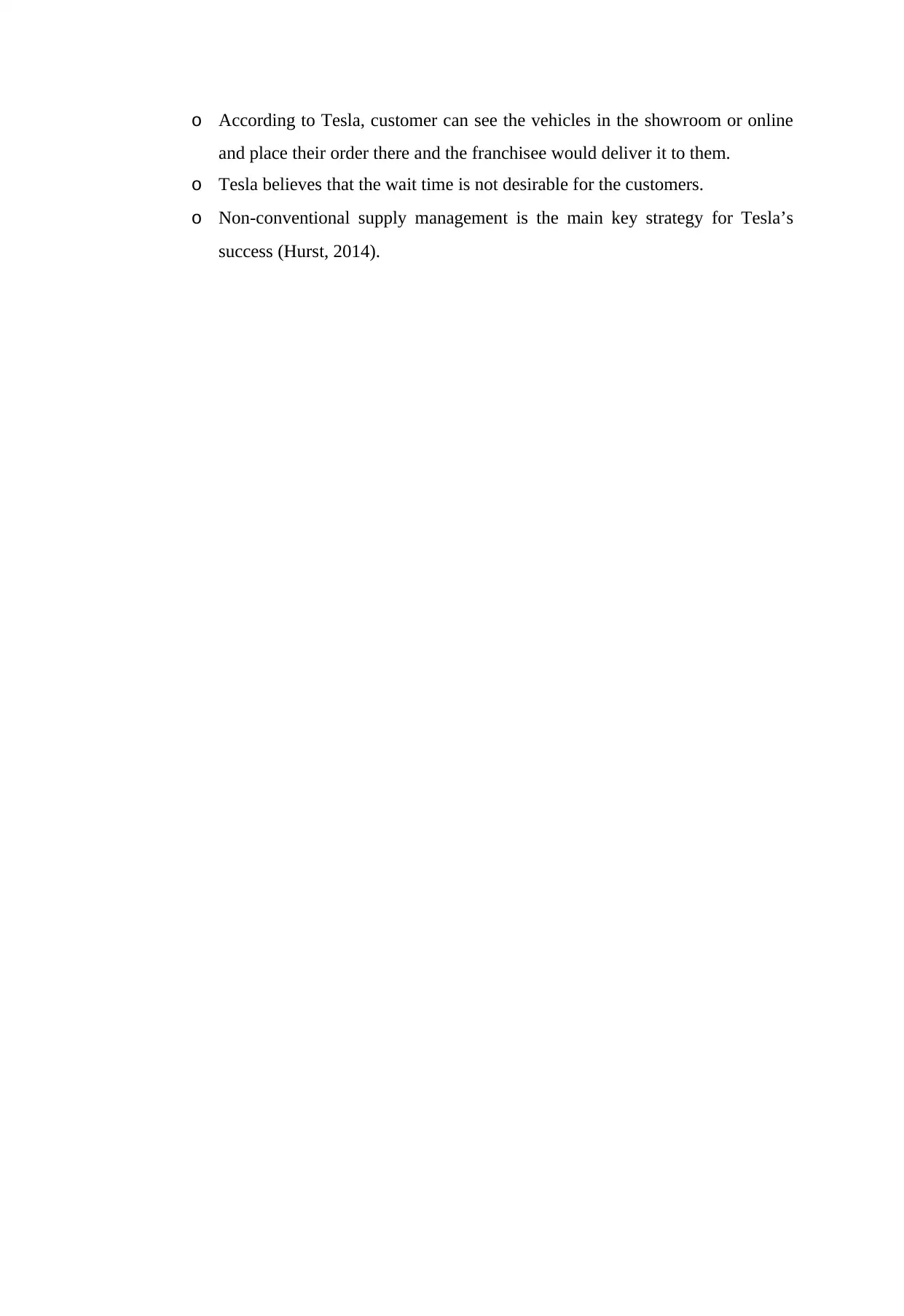
o According to Tesla, customer can see the vehicles in the showroom or online
and place their order there and the franchisee would deliver it to them.
o Tesla believes that the wait time is not desirable for the customers.
o Non-conventional supply management is the main key strategy for Tesla’s
success (Hurst, 2014).
and place their order there and the franchisee would deliver it to them.
o Tesla believes that the wait time is not desirable for the customers.
o Non-conventional supply management is the main key strategy for Tesla’s
success (Hurst, 2014).
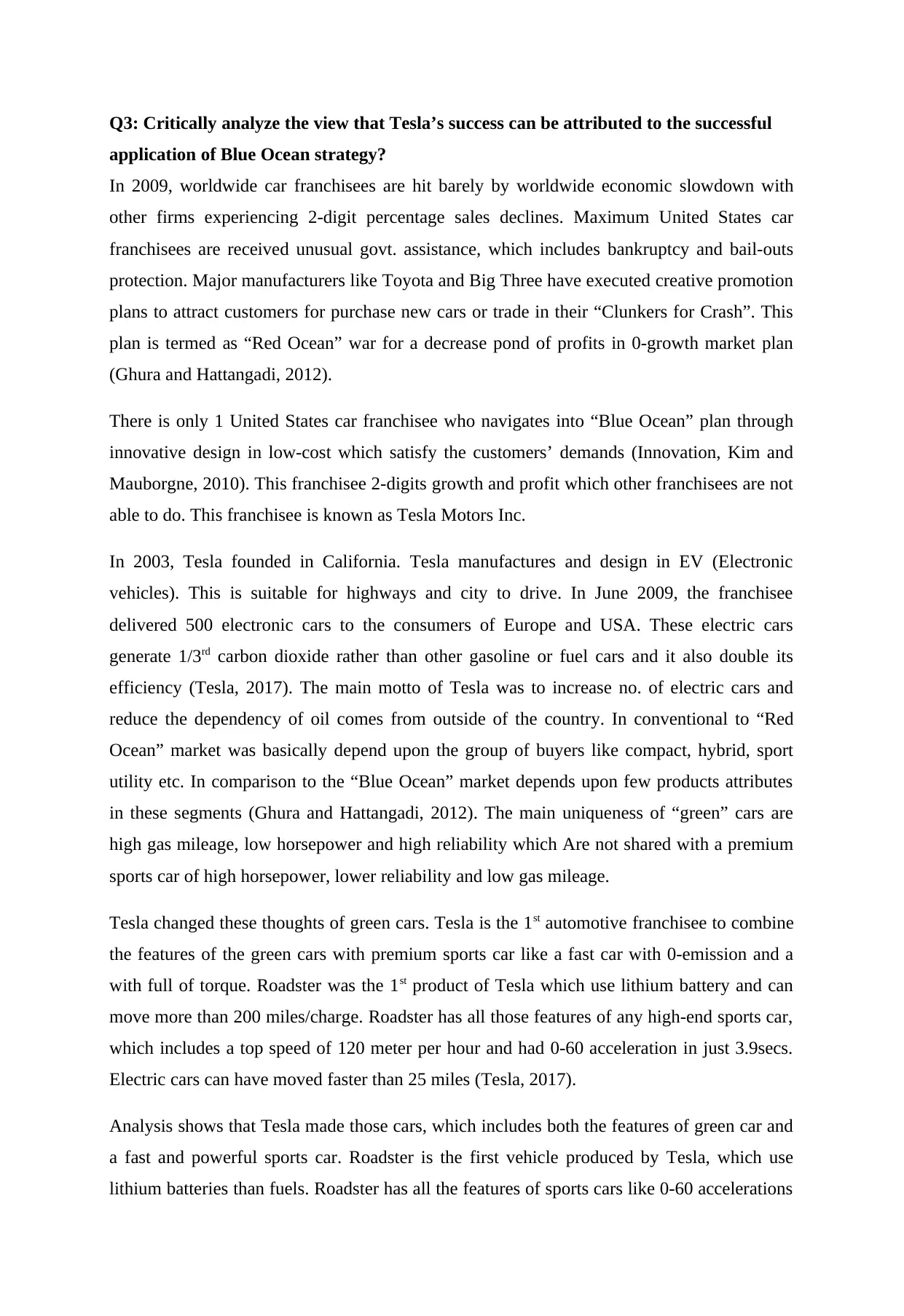
Q3: Critically analyze the view that Tesla’s success can be attributed to the successful
application of Blue Ocean strategy?
In 2009, worldwide car franchisees are hit barely by worldwide economic slowdown with
other firms experiencing 2-digit percentage sales declines. Maximum United States car
franchisees are received unusual govt. assistance, which includes bankruptcy and bail-outs
protection. Major manufacturers like Toyota and Big Three have executed creative promotion
plans to attract customers for purchase new cars or trade in their “Clunkers for Crash”. This
plan is termed as “Red Ocean” war for a decrease pond of profits in 0-growth market plan
(Ghura and Hattangadi, 2012).
There is only 1 United States car franchisee who navigates into “Blue Ocean” plan through
innovative design in low-cost which satisfy the customers’ demands (Innovation, Kim and
Mauborgne, 2010). This franchisee 2-digits growth and profit which other franchisees are not
able to do. This franchisee is known as Tesla Motors Inc.
In 2003, Tesla founded in California. Tesla manufactures and design in EV (Electronic
vehicles). This is suitable for highways and city to drive. In June 2009, the franchisee
delivered 500 electronic cars to the consumers of Europe and USA. These electric cars
generate 1/3rd carbon dioxide rather than other gasoline or fuel cars and it also double its
efficiency (Tesla, 2017). The main motto of Tesla was to increase no. of electric cars and
reduce the dependency of oil comes from outside of the country. In conventional to “Red
Ocean” market was basically depend upon the group of buyers like compact, hybrid, sport
utility etc. In comparison to the “Blue Ocean” market depends upon few products attributes
in these segments (Ghura and Hattangadi, 2012). The main uniqueness of “green” cars are
high gas mileage, low horsepower and high reliability which Are not shared with a premium
sports car of high horsepower, lower reliability and low gas mileage.
Tesla changed these thoughts of green cars. Tesla is the 1st automotive franchisee to combine
the features of the green cars with premium sports car like a fast car with 0-emission and a
with full of torque. Roadster was the 1st product of Tesla which use lithium battery and can
move more than 200 miles/charge. Roadster has all those features of any high-end sports car,
which includes a top speed of 120 meter per hour and had 0-60 acceleration in just 3.9secs.
Electric cars can have moved faster than 25 miles (Tesla, 2017).
Analysis shows that Tesla made those cars, which includes both the features of green car and
a fast and powerful sports car. Roadster is the first vehicle produced by Tesla, which use
lithium batteries than fuels. Roadster has all the features of sports cars like 0-60 accelerations
application of Blue Ocean strategy?
In 2009, worldwide car franchisees are hit barely by worldwide economic slowdown with
other firms experiencing 2-digit percentage sales declines. Maximum United States car
franchisees are received unusual govt. assistance, which includes bankruptcy and bail-outs
protection. Major manufacturers like Toyota and Big Three have executed creative promotion
plans to attract customers for purchase new cars or trade in their “Clunkers for Crash”. This
plan is termed as “Red Ocean” war for a decrease pond of profits in 0-growth market plan
(Ghura and Hattangadi, 2012).
There is only 1 United States car franchisee who navigates into “Blue Ocean” plan through
innovative design in low-cost which satisfy the customers’ demands (Innovation, Kim and
Mauborgne, 2010). This franchisee 2-digits growth and profit which other franchisees are not
able to do. This franchisee is known as Tesla Motors Inc.
In 2003, Tesla founded in California. Tesla manufactures and design in EV (Electronic
vehicles). This is suitable for highways and city to drive. In June 2009, the franchisee
delivered 500 electronic cars to the consumers of Europe and USA. These electric cars
generate 1/3rd carbon dioxide rather than other gasoline or fuel cars and it also double its
efficiency (Tesla, 2017). The main motto of Tesla was to increase no. of electric cars and
reduce the dependency of oil comes from outside of the country. In conventional to “Red
Ocean” market was basically depend upon the group of buyers like compact, hybrid, sport
utility etc. In comparison to the “Blue Ocean” market depends upon few products attributes
in these segments (Ghura and Hattangadi, 2012). The main uniqueness of “green” cars are
high gas mileage, low horsepower and high reliability which Are not shared with a premium
sports car of high horsepower, lower reliability and low gas mileage.
Tesla changed these thoughts of green cars. Tesla is the 1st automotive franchisee to combine
the features of the green cars with premium sports car like a fast car with 0-emission and a
with full of torque. Roadster was the 1st product of Tesla which use lithium battery and can
move more than 200 miles/charge. Roadster has all those features of any high-end sports car,
which includes a top speed of 120 meter per hour and had 0-60 acceleration in just 3.9secs.
Electric cars can have moved faster than 25 miles (Tesla, 2017).
Analysis shows that Tesla made those cars, which includes both the features of green car and
a fast and powerful sports car. Roadster is the first vehicle produced by Tesla, which use
lithium batteries than fuels. Roadster has all the features of sports cars like 0-60 accelerations
⊘ This is a preview!⊘
Do you want full access?
Subscribe today to unlock all pages.

Trusted by 1+ million students worldwide
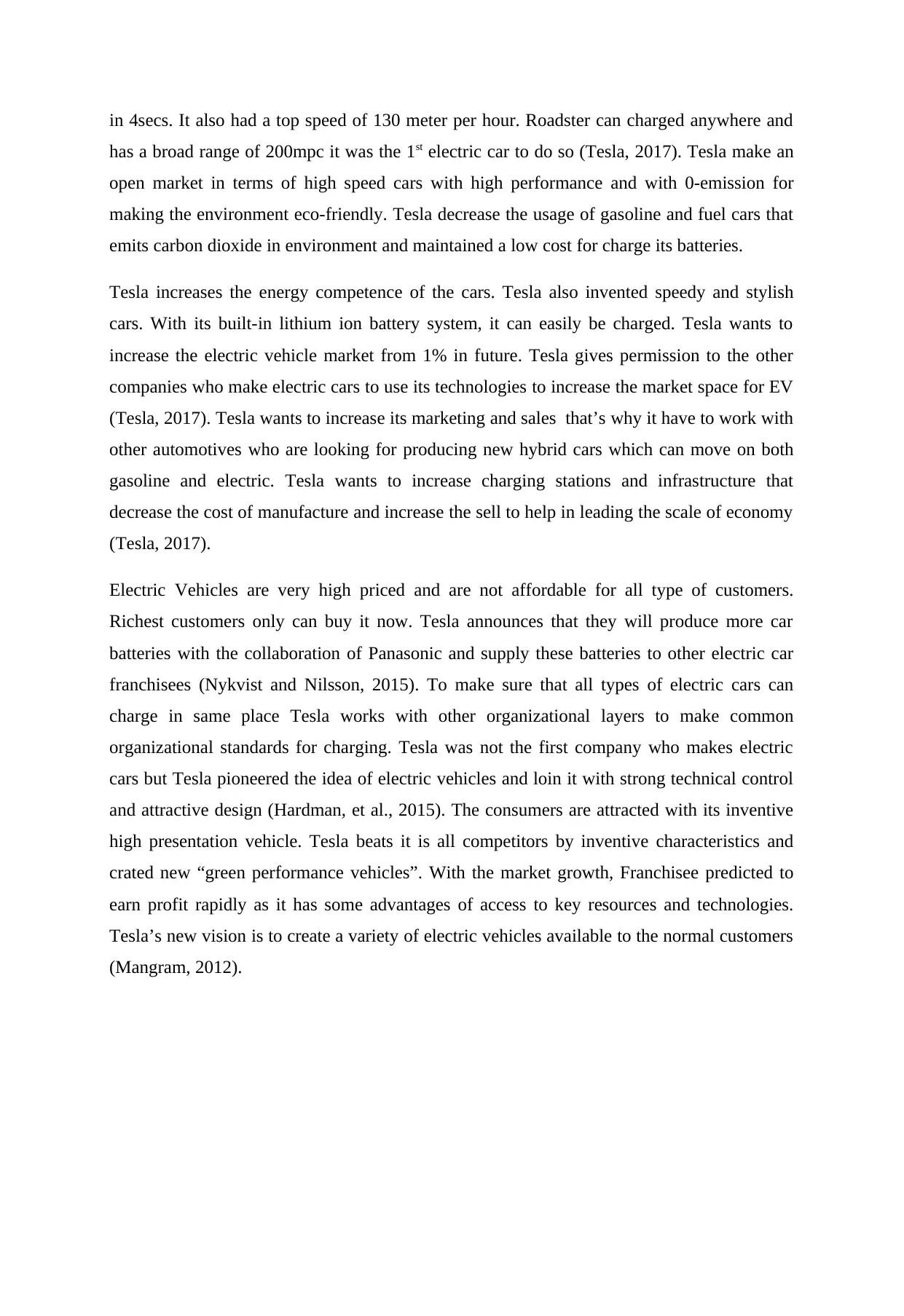
in 4secs. It also had a top speed of 130 meter per hour. Roadster can charged anywhere and
has a broad range of 200mpc it was the 1st electric car to do so (Tesla, 2017). Tesla make an
open market in terms of high speed cars with high performance and with 0-emission for
making the environment eco-friendly. Tesla decrease the usage of gasoline and fuel cars that
emits carbon dioxide in environment and maintained a low cost for charge its batteries.
Tesla increases the energy competence of the cars. Tesla also invented speedy and stylish
cars. With its built-in lithium ion battery system, it can easily be charged. Tesla wants to
increase the electric vehicle market from 1% in future. Tesla gives permission to the other
companies who make electric cars to use its technologies to increase the market space for EV
(Tesla, 2017). Tesla wants to increase its marketing and sales that’s why it have to work with
other automotives who are looking for producing new hybrid cars which can move on both
gasoline and electric. Tesla wants to increase charging stations and infrastructure that
decrease the cost of manufacture and increase the sell to help in leading the scale of economy
(Tesla, 2017).
Electric Vehicles are very high priced and are not affordable for all type of customers.
Richest customers only can buy it now. Tesla announces that they will produce more car
batteries with the collaboration of Panasonic and supply these batteries to other electric car
franchisees (Nykvist and Nilsson, 2015). To make sure that all types of electric cars can
charge in same place Tesla works with other organizational layers to make common
organizational standards for charging. Tesla was not the first company who makes electric
cars but Tesla pioneered the idea of electric vehicles and loin it with strong technical control
and attractive design (Hardman, et al., 2015). The consumers are attracted with its inventive
high presentation vehicle. Tesla beats it is all competitors by inventive characteristics and
crated new “green performance vehicles”. With the market growth, Franchisee predicted to
earn profit rapidly as it has some advantages of access to key resources and technologies.
Tesla’s new vision is to create a variety of electric vehicles available to the normal customers
(Mangram, 2012).
has a broad range of 200mpc it was the 1st electric car to do so (Tesla, 2017). Tesla make an
open market in terms of high speed cars with high performance and with 0-emission for
making the environment eco-friendly. Tesla decrease the usage of gasoline and fuel cars that
emits carbon dioxide in environment and maintained a low cost for charge its batteries.
Tesla increases the energy competence of the cars. Tesla also invented speedy and stylish
cars. With its built-in lithium ion battery system, it can easily be charged. Tesla wants to
increase the electric vehicle market from 1% in future. Tesla gives permission to the other
companies who make electric cars to use its technologies to increase the market space for EV
(Tesla, 2017). Tesla wants to increase its marketing and sales that’s why it have to work with
other automotives who are looking for producing new hybrid cars which can move on both
gasoline and electric. Tesla wants to increase charging stations and infrastructure that
decrease the cost of manufacture and increase the sell to help in leading the scale of economy
(Tesla, 2017).
Electric Vehicles are very high priced and are not affordable for all type of customers.
Richest customers only can buy it now. Tesla announces that they will produce more car
batteries with the collaboration of Panasonic and supply these batteries to other electric car
franchisees (Nykvist and Nilsson, 2015). To make sure that all types of electric cars can
charge in same place Tesla works with other organizational layers to make common
organizational standards for charging. Tesla was not the first company who makes electric
cars but Tesla pioneered the idea of electric vehicles and loin it with strong technical control
and attractive design (Hardman, et al., 2015). The consumers are attracted with its inventive
high presentation vehicle. Tesla beats it is all competitors by inventive characteristics and
crated new “green performance vehicles”. With the market growth, Franchisee predicted to
earn profit rapidly as it has some advantages of access to key resources and technologies.
Tesla’s new vision is to create a variety of electric vehicles available to the normal customers
(Mangram, 2012).
Paraphrase This Document
Need a fresh take? Get an instant paraphrase of this document with our AI Paraphraser
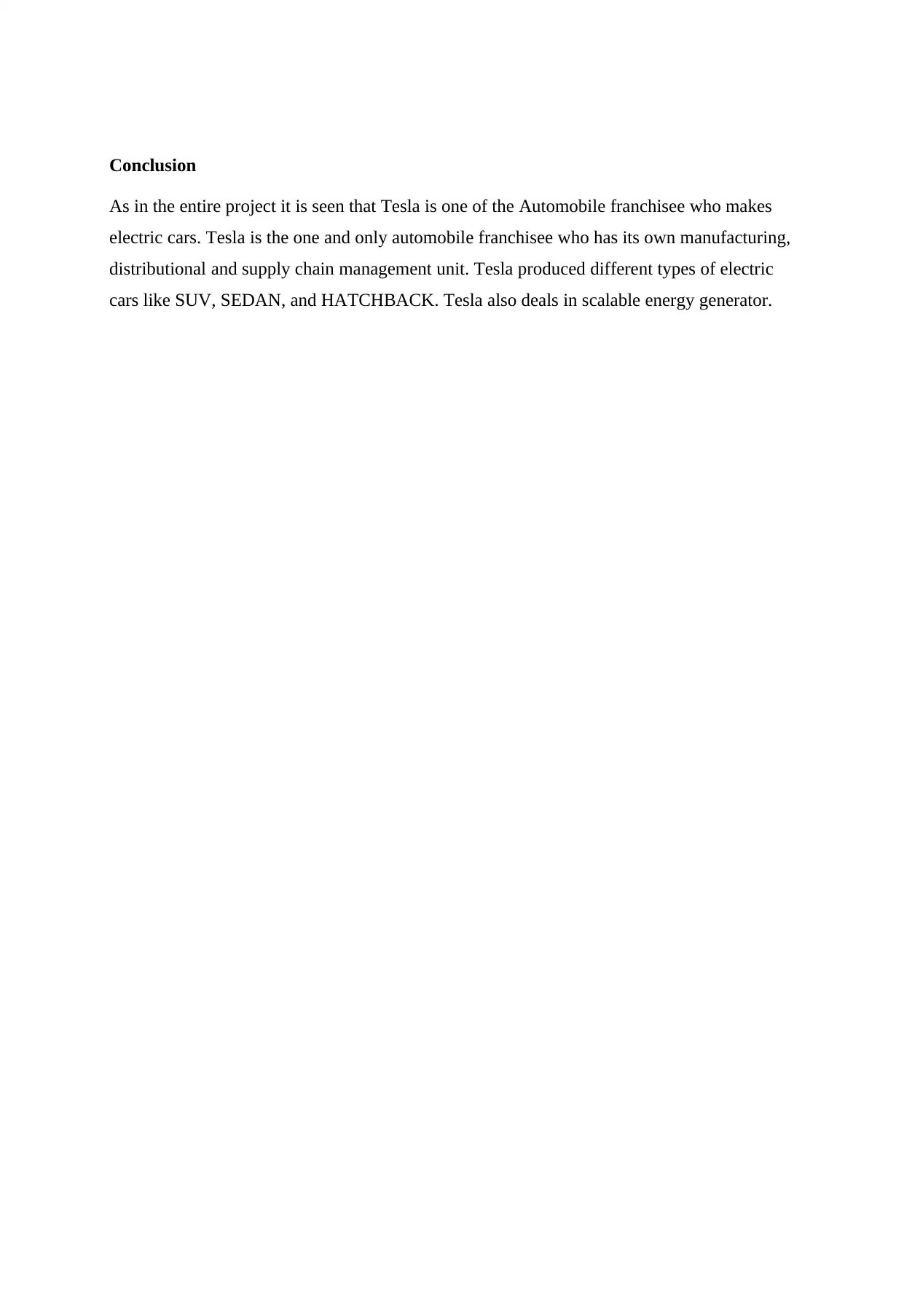
Conclusion
As in the entire project it is seen that Tesla is one of the Automobile franchisee who makes
electric cars. Tesla is the one and only automobile franchisee who has its own manufacturing,
distributional and supply chain management unit. Tesla produced different types of electric
cars like SUV, SEDAN, and HATCHBACK. Tesla also deals in scalable energy generator.
As in the entire project it is seen that Tesla is one of the Automobile franchisee who makes
electric cars. Tesla is the one and only automobile franchisee who has its own manufacturing,
distributional and supply chain management unit. Tesla produced different types of electric
cars like SUV, SEDAN, and HATCHBACK. Tesla also deals in scalable energy generator.
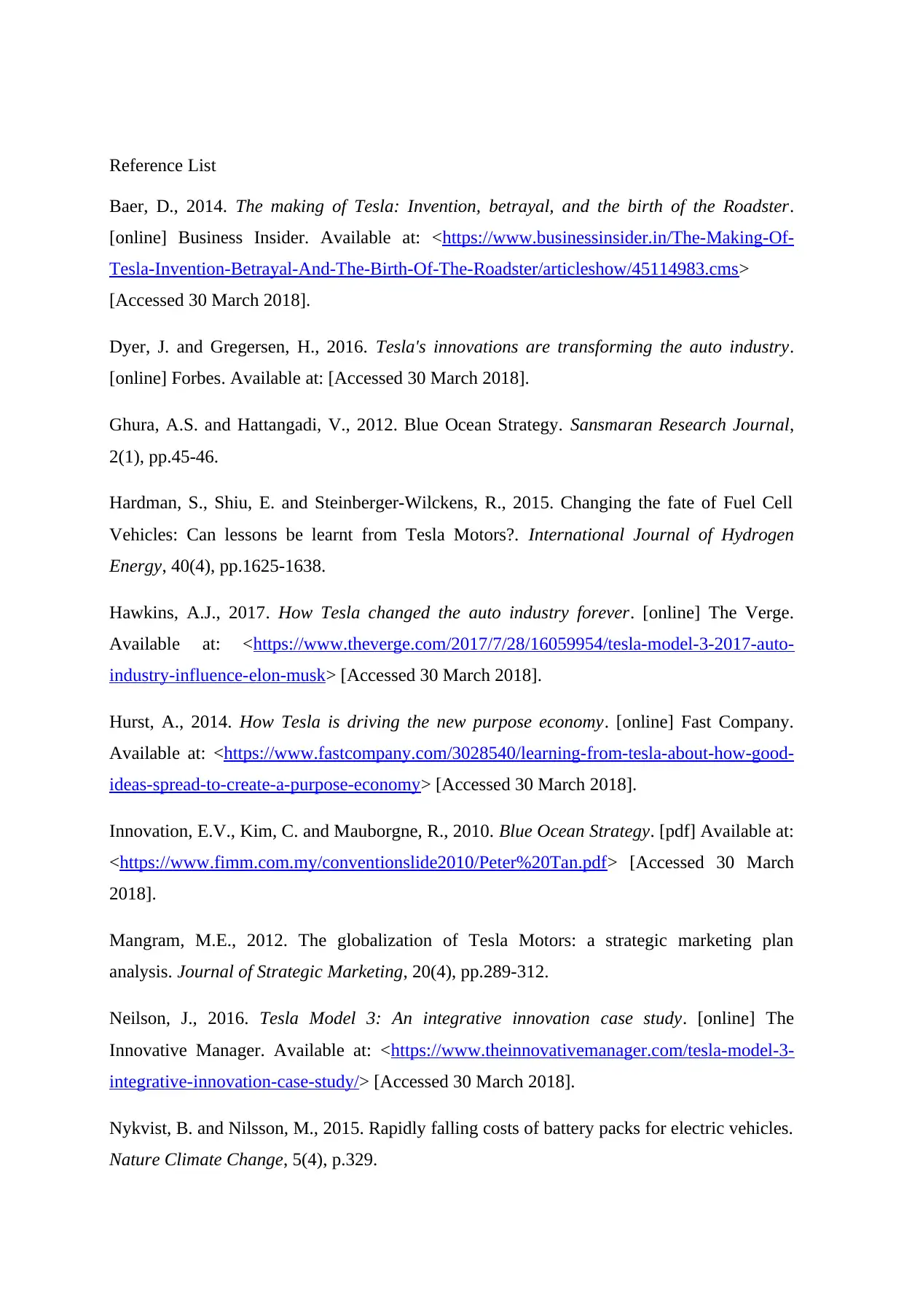
Reference List
Baer, D., 2014. The making of Tesla: Invention, betrayal, and the birth of the Roadster.
[online] Business Insider. Available at: <https://www.businessinsider.in/The-Making-Of-
Tesla-Invention-Betrayal-And-The-Birth-Of-The-Roadster/articleshow/45114983.cms>
[Accessed 30 March 2018].
Dyer, J. and Gregersen, H., 2016. Tesla's innovations are transforming the auto industry.
[online] Forbes. Available at: [Accessed 30 March 2018].
Ghura, A.S. and Hattangadi, V., 2012. Blue Ocean Strategy. Sansmaran Research Journal,
2(1), pp.45-46.
Hardman, S., Shiu, E. and Steinberger-Wilckens, R., 2015. Changing the fate of Fuel Cell
Vehicles: Can lessons be learnt from Tesla Motors?. International Journal of Hydrogen
Energy, 40(4), pp.1625-1638.
Hawkins, A.J., 2017. How Tesla changed the auto industry forever. [online] The Verge.
Available at: <https://www.theverge.com/2017/7/28/16059954/tesla-model-3-2017-auto-
industry-influence-elon-musk> [Accessed 30 March 2018].
Hurst, A., 2014. How Tesla is driving the new purpose economy. [online] Fast Company.
Available at: <https://www.fastcompany.com/3028540/learning-from-tesla-about-how-good-
ideas-spread-to-create-a-purpose-economy> [Accessed 30 March 2018].
Innovation, E.V., Kim, C. and Mauborgne, R., 2010. Blue Ocean Strategy. [pdf] Available at:
<https://www.fimm.com.my/conventionslide2010/Peter%20Tan.pdf> [Accessed 30 March
2018].
Mangram, M.E., 2012. The globalization of Tesla Motors: a strategic marketing plan
analysis. Journal of Strategic Marketing, 20(4), pp.289-312.
Neilson, J., 2016. Tesla Model 3: An integrative innovation case study. [online] The
Innovative Manager. Available at: <https://www.theinnovativemanager.com/tesla-model-3-
integrative-innovation-case-study/> [Accessed 30 March 2018].
Nykvist, B. and Nilsson, M., 2015. Rapidly falling costs of battery packs for electric vehicles.
Nature Climate Change, 5(4), p.329.
Baer, D., 2014. The making of Tesla: Invention, betrayal, and the birth of the Roadster.
[online] Business Insider. Available at: <https://www.businessinsider.in/The-Making-Of-
Tesla-Invention-Betrayal-And-The-Birth-Of-The-Roadster/articleshow/45114983.cms>
[Accessed 30 March 2018].
Dyer, J. and Gregersen, H., 2016. Tesla's innovations are transforming the auto industry.
[online] Forbes. Available at: [Accessed 30 March 2018].
Ghura, A.S. and Hattangadi, V., 2012. Blue Ocean Strategy. Sansmaran Research Journal,
2(1), pp.45-46.
Hardman, S., Shiu, E. and Steinberger-Wilckens, R., 2015. Changing the fate of Fuel Cell
Vehicles: Can lessons be learnt from Tesla Motors?. International Journal of Hydrogen
Energy, 40(4), pp.1625-1638.
Hawkins, A.J., 2017. How Tesla changed the auto industry forever. [online] The Verge.
Available at: <https://www.theverge.com/2017/7/28/16059954/tesla-model-3-2017-auto-
industry-influence-elon-musk> [Accessed 30 March 2018].
Hurst, A., 2014. How Tesla is driving the new purpose economy. [online] Fast Company.
Available at: <https://www.fastcompany.com/3028540/learning-from-tesla-about-how-good-
ideas-spread-to-create-a-purpose-economy> [Accessed 30 March 2018].
Innovation, E.V., Kim, C. and Mauborgne, R., 2010. Blue Ocean Strategy. [pdf] Available at:
<https://www.fimm.com.my/conventionslide2010/Peter%20Tan.pdf> [Accessed 30 March
2018].
Mangram, M.E., 2012. The globalization of Tesla Motors: a strategic marketing plan
analysis. Journal of Strategic Marketing, 20(4), pp.289-312.
Neilson, J., 2016. Tesla Model 3: An integrative innovation case study. [online] The
Innovative Manager. Available at: <https://www.theinnovativemanager.com/tesla-model-3-
integrative-innovation-case-study/> [Accessed 30 March 2018].
Nykvist, B. and Nilsson, M., 2015. Rapidly falling costs of battery packs for electric vehicles.
Nature Climate Change, 5(4), p.329.
⊘ This is a preview!⊘
Do you want full access?
Subscribe today to unlock all pages.

Trusted by 1+ million students worldwide
1 out of 13
Related Documents
Your All-in-One AI-Powered Toolkit for Academic Success.
+13062052269
info@desklib.com
Available 24*7 on WhatsApp / Email
![[object Object]](/_next/static/media/star-bottom.7253800d.svg)
Unlock your academic potential
Copyright © 2020–2025 A2Z Services. All Rights Reserved. Developed and managed by ZUCOL.




